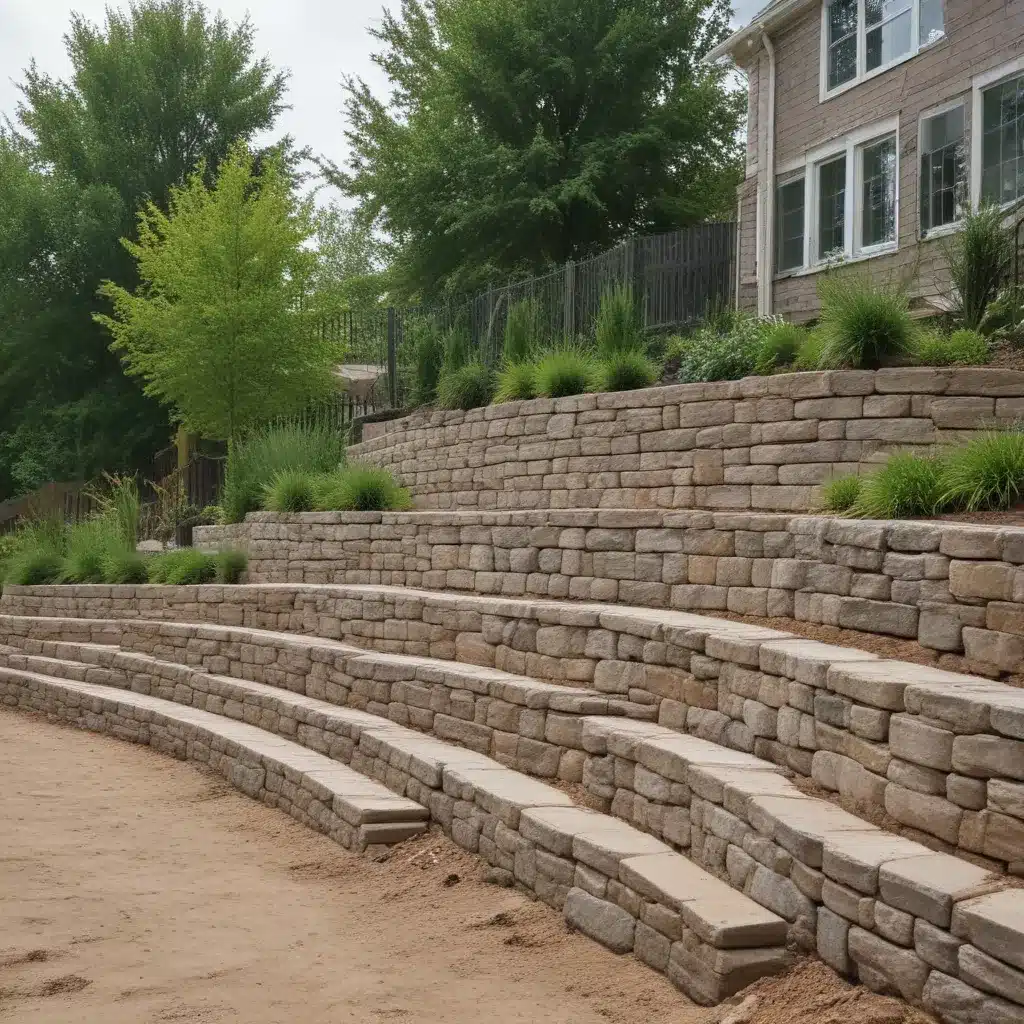
Retaining Walls Revitalized: Transforming Sloped Landscapes with Elegance
Retaining walls have long been a practical solution for managing challenging terrain, but today’s homeowners are discovering their untapped potential as both functional and aesthetically pleasing landscape elements. Whether you’re faced with a sloping backyard, uneven grades, or the need to create usable outdoor living spaces, strategically designed retaining walls can transform your landscape into a harmonious and visually stunning oasis.
Retaining Wall Fundamentals
Purpose and Benefits of Retaining Walls
At their core, retaining walls serve the essential purpose of holding back soil and preventing erosion on sloped or terraced landscapes. By providing structural support, they create stable, level areas that can be utilized for a variety of outdoor living features, from seating walls and planting beds to fire pits and dining spaces. Retaining walls also help to manage water drainage, guiding runoff and minimizing the risk of flooding or soil saturation.
Types of Retaining Wall Materials
The material selection for your retaining wall is a crucial design decision that can significantly impact the overall look and feel of your outdoor space. Homeowners have a wide range of options, including:
- Natural Stone: Timeless and durable, natural stone retaining walls, such as those made from fieldstone, limestone, or granite, offer a classic and rustic aesthetic that blends seamlessly with most landscape styles.
- Concrete: Concrete retaining walls are a popular choice for their strength, versatility, and cost-effectiveness. They can be designed to mimic the appearance of natural stone or incorporate various textures and colors.
- Interlocking Blocks: Modular retaining wall systems, often made from concrete or manufactured stone, provide a simple and efficient installation process while allowing for customizable design elements.
- Timber: Wooden retaining walls, typically constructed from pressure-treated or rot-resistant lumber, can create a warm, natural look that complements rustic or cottage-style landscapes.
The selection of retaining wall materials should be guided by factors such as the overall design aesthetic, the scale and slope of the landscape, and the desired functionality of the space.
Landscape Design Considerations
Integrating Retaining Walls into Sloped Terrain
When dealing with challenging slopes or uneven ground, retaining walls can be strategically incorporated to transform the landscape into a series of usable, tiered spaces. By creating a stepped or terraced effect, retaining walls allow homeowners to maximize the functionality of their outdoor area, providing level platforms for patios, gardens, or seating areas.
Complementary Hardscaping and Softscaping Elements
To achieve a cohesive and visually stunning outdoor living space, it’s essential to consider how retaining walls will interact with other hardscaping and softscaping elements. Paver patios, walkways, and steps can be seamlessly integrated with retaining walls, creating a smooth flow and transition between different areas of the landscape. Complementary plantings, such as
flowering shrubs, ornamental grasses, or cascading vines, can soften the look of the retaining wall and add layers of texture and color to the overall design.
Aesthetic Enhancements
Decorative Retaining Wall Finishes
Beyond their practical applications, retaining walls can be elevated to serve as design focal points within the landscape. Homeowners can explore a variety of decorative finishes and textures to enhance the visual appeal of their retaining walls, including:
- Natural Stone Veneers: Applying thin, natural stone veneers to the face of a retaining wall can create the illusion of a solid stone structure while offering a more cost-effective solution.
- Patterned Concrete: Stamped, stained, or textured concrete retaining walls can mimic the look of natural stone or other materials, adding visual interest to the landscape.
- Architectural Detailing: Incorporating architectural elements like columns, arches, or decorative caps can transform a utilitarian retaining wall into a statement piece.
Incorporating Lighting and Plantings
Thoughtful lighting and strategic plantings can further elevate the aesthetic appeal of retaining walls. Subtle path lighting or uplighting can accentuate the wall’s texture and highlight its architectural features, creating a warm and inviting ambiance in the evening. Lush greenery, such as cascading vines, flowering perennials, or ornamental grasses, can soften the hard lines of the retaining wall and add a touch of organic beauty to the landscape.
Structural Integrity and Durability
Engineering and Construction Techniques
Ensuring the structural integrity and long-term durability of a retaining wall is crucial, as these hardscaping features must withstand the pressures of soil, water, and weather. Proper engineering and construction techniques, such as incorporating drainage systems, reinforcing with rebar or geogrid, and compacting the soil base, are essential for creating a sturdy and reliable retaining wall.
Maintenance and Repair Considerations
Even the most well-built retaining walls may require occasional maintenance or repairs over time. Regular inspections, clearing debris and vegetation, and addressing any signs of cracking or shifting can help to prolong the life of your retaining wall and maintain its aesthetic appeal. In the event of more significant damage, working with a professional landscape contractor or mason can ensure the proper restoration and reinforcement of the structure.
By understanding the fundamental principles of retaining walls, thoughtfully integrating them into your landscape design, and prioritizing both aesthetics and structural integrity, homeowners can transform their sloped or uneven outdoor spaces into beautiful, functional, and enduring outdoor living environments. Whether you’re looking to create usable terraced areas, enhance the visual appeal of your landscape, or address drainage and erosion challenges, a well-designed retaining wall can be a transformative addition to any outdoor living space.

